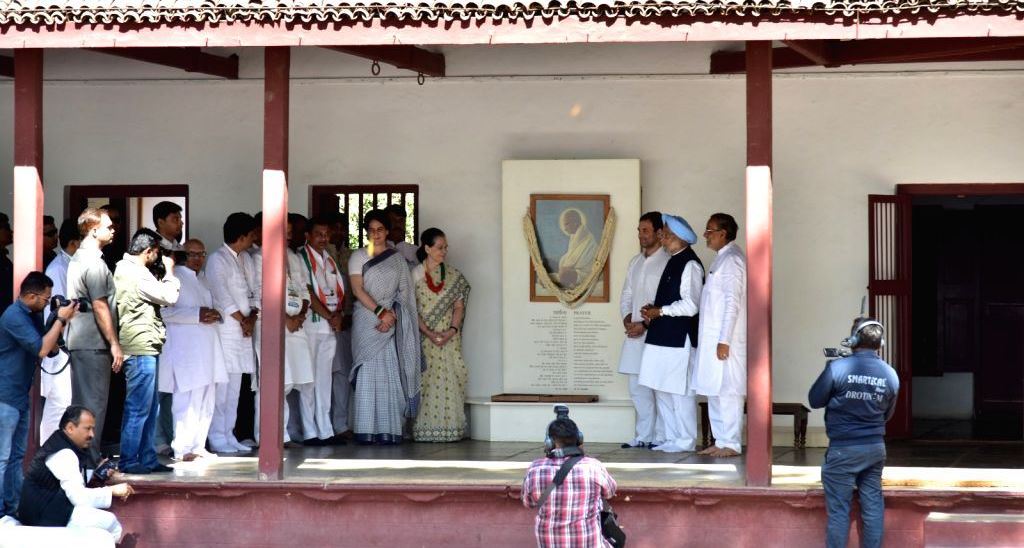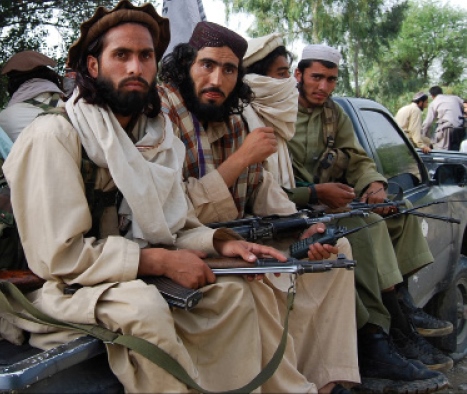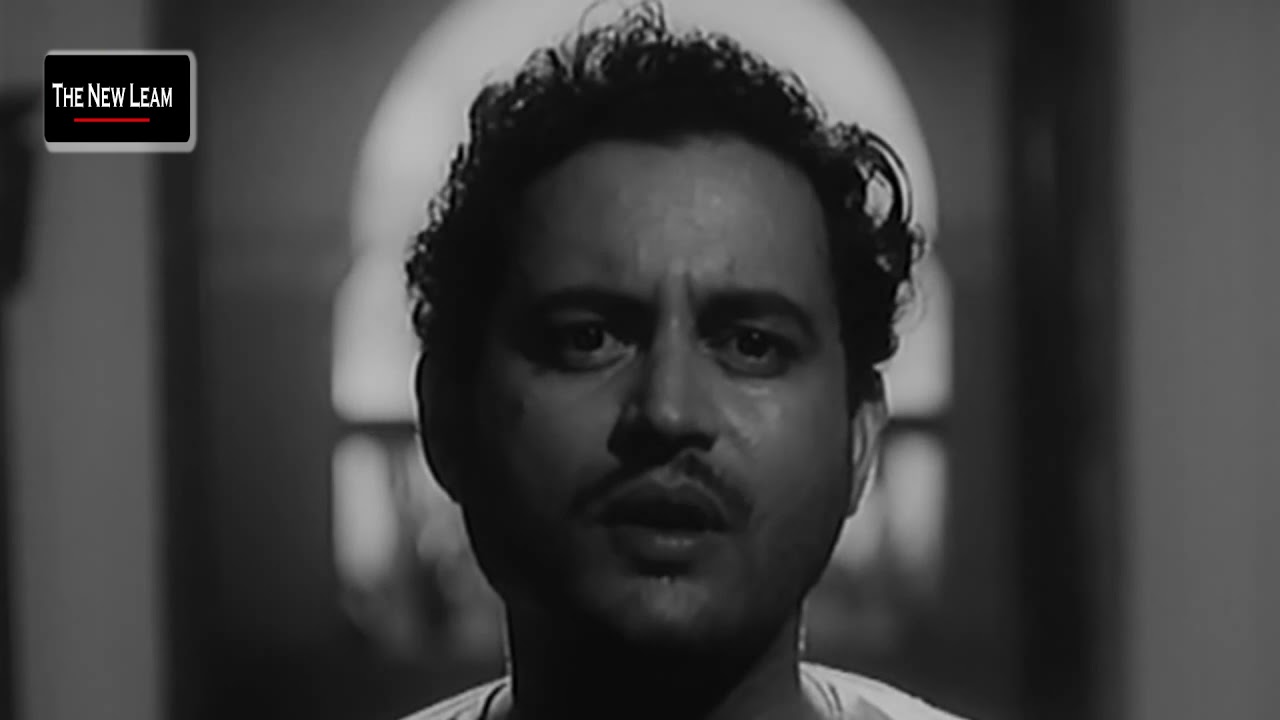Gandhi family’s visit to the Sabarmati Ashram on the 89th anniversary of the Dandi March ahead of the upcoming Lok Sabha elections and Prime Minster Modi’s commentary on the Congress being essentially an anti-thesis of Gandhian ideals – has revealed how Gandhi continues to be a much appropriated symbol within India’s political culture.
The New Leam Staff

On 12th March when the Gandhi family visited the historic Sabarmati Ashram in Ahmedabad on the anniversary of the historic Dandi March, all the national newspapers carried photographs of the visit. Rahul Gandhi was accompanied by UPA Chairperson Sonia Gandhi and party general secretary in-charge of eastern- Uttar Pradesh Priyanka Gandhi along with former Prime Minister Manmohan Singh.
The Gandhi family along with former Prime Minister Manmohan Singh also attended the prayer meeting held at the ashram. Their visit to the Sabarmati Ashram is an important gesture ahead of the Lok Sabha elections that are coming up from April. Rahul Gandhi along with other members of the Congress is also going to hold a meeting of the Congress Working-Committee in the state ahead of the polls. It is in this meeting that Hardik Patel shall formally join the Congress and be inducted into the party.
Along with this, Priyanka Gandhi also addressed her first major political rally in Gujarat’s Adalaj since the time she was appointed as the in-charge of UP east for the 2019 election campaign of the Congress. We should remember that this was Rahul Gandhi’s second visit to Narendra Modi’s home state ahead of the Lok Sabha elections.
In response to the visit of the key members of the Congress to the Sabarmati Ashram, Prime Minister Narendra Modi has said that the Congress is essentially the anti-thesis of Gandhi. And that the culture of the Opposition was dominated by anti-Gandhian ideals. He asserted that while Gandhi was against the existence of political dynasties, the Congress itself was a dynasty and this is something that Gandhi would never have approved of.
On the 89th anniversary of the Dandi March when PM Modi makes such a statement, it makes it clear that the culture of Indian politics is one that is based on the excessive use of nationalist symbols and utilitarian understanding of nationalist leaders such as Mahatma Gandhi and Bhagat Singh. Prime Minister Modi claimed that all the work that his party had been doing was in tune with Mahatma Gandhi’s dreams and that the Opposition was opposed to his great ideals.
The allegation made by the PM was that while Gandhi was against caste hierarchy and the perpetuation of social hierarchy, it was in the congress regime that inequality and caste hierarchy were at their peak and the worst anti-Dalit massacres had unfolded.
It is important to note that even if one were to leave aside what Congress had done during its regime, what cannot be denied is that PM Modi has been steadfastly trying to appropriate Gandhi in his political career. So when he condemns the Congress for being against Bapu because unlike Bapu who never believed in hoarding wealth , the Congress leaders had their accounts full of money at the cost of the common people of the nation- he must ask himself what paths his own party has chosen as far as the appropriation of wealth goes.
What about the fact that an important defence contract was given to a businessman friend instead of a national company with a promise to bring about unprecedented profits?
What about being photographed with business tycoons who fled away stealing a wide amount of the nation’s money?
What about the lakhs and crores of money that is spent annually on advertisements and statues when we need so many schools, hospitals and roads in the nation?
While the Congress may have overlooked many of the Gandhian ideals it claimed to adhere to and many of its leaders may have taken to corruption, but will that alone prove the BJP is more Gandhian?
In the run up to the Lok Sabha elections, we see how the ruling and the Opposition parties are playing a blame game and repeatedly trying to prove that the other is more corrupt. While the Congress has called the PM ‘Chowkidar he Chor Hai’ ( The guard himself is the thief) and other derogatory names, the BJP has labelled all sorts of allegations against the Congress such as the character assassination of the members of the Gandhi family, the nepotism and dynastic politics label, the friend of Pakistan and terror appeasement rhetoric along with trying as hard as they can to prove that Rahul Gandhi is dumb and a failure. It is clear that the ruling regime is fearful that the revival of the Congress can turn into a nucleus for the unity of the Opposition parties and it can attract a great chunk of anti-BJP votes. Amidst all these we see the lowered standards of Indian politics, the noisy and uncivilized culture of name calling, the degeneration of civility and mature political conduct and the increasing need among political parties to demean the other to prove their own worth.
While the economic policies, the defence deals, the welfare schemes, the matters of employment, education and food security continue to be some of key sectors where governments ought to deliver, neither of the parties is in complete sync with Gandhi’s ideals and none has proven its credibility to be called Gandhian by vision. It is indeed a game characterised by appropriations of the symbols associated with Gandhi and an overarching need to exploit his name for immediate political legitimacy. We indeed find ourselves in a dark political void characterised by a legitimation crisis.
Gandhian ideals and his vision for India have been trampled upon time and again, he has been reduced into a state appropriated symbol- a photograph hung in police stations, courts, public offices and railway stations, a statue in every Indian town, the name of an important road in the city or a public library, a face on currency notes and a last resort for political leaders in times of legitimation crisis.
Where is Gandhi when we move towards enhanced centralisation and take away all power from the village community?
What about Gandhi when we allow our artisans, farmers and skilled artisans to die in poverty?
Where is Gandhi when we begin to hoard nuclear arms, spend the largest amount of our funds on defence when there is rampant poverty?
Where is Gandhi’s educational vision in our posh public schools that distance the child from the reality around her?
We utilise Gandhi’s name in our election rhetoric, in proving the falsehood of the Opponent and demeaning the politics of the other. Gandhi is absent from India’s political map, and bringing him back will not be an easy task.














